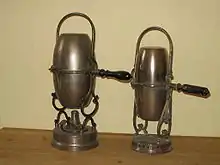Neapolitan flip coffee pot
The Neapolitan flip coffee pot (Italian: napoletana or caffettiera napoletana, pronounced [kaffetˈtjɛːra napoleˈtaːna]; Neapolitan: cuccumella, pronounced [kukkuˈmɛllə]) is a drip brew coffeemaker for the stove top that was very popular in Italy until the 20th century. Unlike a moka express, a napoletana does not use the pressure of steam to force the water through the coffee, relying instead on gravity.


History
The napoletana was invented in 1819 by a Frenchman named Morize.[1][2] It was originally constructed out of copper, until 1886, when the material was switched to aluminum. The reason for taking its name from the city of Naples is due to the fact that Morize was in love with a Neapolitan girl. The namesake cuccumella derives from cuccuma, meaning "copper or terracotta vase".[3]
Structure and use
It consists of a bottom section filled with water, a filter section in the middle filled with finely ground coffee, and an upside-down pot placed on the top. When the water boils, the entire three-part coffee maker is flipped over to let the water filter through the coffee grounds. Once the water has dripped through the grounds, the water-boiling and filter sections are removed, and the coffee is served from the remaining pot. If coarse grounds are used, the coffee is brewed quite mildly. Using very finely ground coffee in the "Neapolitan" style, roasted colour "cloak of monk", this method can produce a coffee that has a stronger flavor than an automatic drip brew maker.
Cuppetiello
The cuppetiello is a small paper cone (which is used in other ways in Naples, such as holding food) that goes over the spout. This is used to preserve the aroma of the coffee while it drips into the tank, which can take up to 10 minutes or more. To make a cuppetiello, a small piece of paper is folded to create a cone shape. Eduardo de Filippo offers a description of the cuppetiello and the importance of coffee in Naples.[4]
Variants

Some of the finely crafted coffee pots manufactured in the late 19th century work on the same principle, including the Russische Eikanne (engl. "Russian egg pot") and the Potsdamer Boiler (engl. "Potsdam boiler"). Another variant was the Arndt'sche Sturzmaschine[5] (not to be confused with the Arndt'sche Caffee-Aufgussmaschine). A spiritus cooker heats the mounted flippable pot.
Classic designs
Italian Riccardo Dalisi redesigned this classic for Alessi. He began his research in 1979 and earned international attention when his design entered into production in 1987.[6] As they have come back to gain some popularity, Ilsa now also makes them in stainless steel.
See also
- Moka pot - similar looking, but different type of pot
- Cafetière du Belloy - similar looking, but different type of pots
References
- William H. Ukers, All About Coffee, New York, The Tea and Coffee Trade Journal Company, 1922, cap. 34.
- "Selecting a Coffee Brewing Method". sallybernstein.com.
- "CUCCUMELLA - Definition and synonyms of cuccumella in the Italian dictionary". educalingo.com.
- "Eduardo de Filippo - scena del caffè.mov". YouTube.
- "Arndt´sche Sturzmaschine". 11 November 2020. Archived from the original on 2023-05-01.
- "Riccardo Dalisi Biografia | archimagazine". www.archimagazine.com.